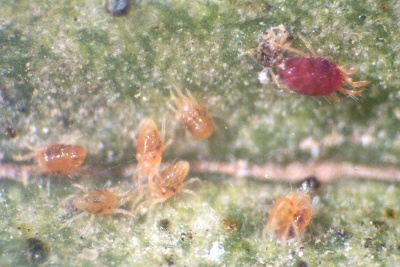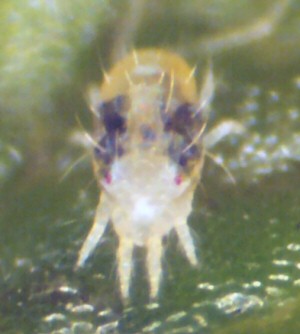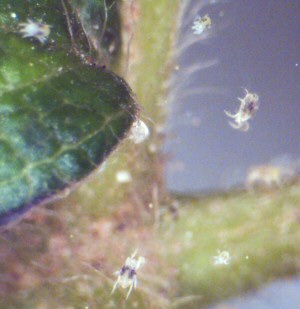Spider Mites
 Hosts
Hosts
Some species of spider mites are restricted to one or a few kinds of host plants while others feed on many different kinds of plants. Tomatoes and marigolds are probably most commonly attacked in Oklahoma, but very few plants are completely immune from all the species of spider mites that will attack plants.
Symptoms
 Damage occurs when the mites suck plant juices with their small, needle-like mouthparts.
Light infestations leave a pattern of small, pale spots on the infested plant. With
heavier infestations the individual spots run together and can cause the death of
a leaf or needle. This type of damage is often the only sign of an infestation in
species which do not spin webs.
Damage occurs when the mites suck plant juices with their small, needle-like mouthparts.
Light infestations leave a pattern of small, pale spots on the infested plant. With
heavier infestations the individual spots run together and can cause the death of
a leaf or needle. This type of damage is often the only sign of an infestation in
species which do not spin webs.
Life Cycle
Some species overwinter as adults and others overwinter as eggs. They hatch or become active as the weather warms in the spring. Hot, dry weather is favorable for most spider mites and during the summer months they can complete a generation in 7 to 14 days. Females lay as many as 300 eggs in their webs or on plants. Therefore, mite infestations can increase rapidly and cause extensive damage to plants in a short time. Infestations usually decline as the weather becomes cooler and wetter in the fall.
Description
 Spider mites, often called red spiders, are very small, barely visible to the naked
eye. The newly hatched mite has 6 legs but all other active stages have 8 legs. They
are related to spiders and ticks and are not insects. We have several different species
in Oklahoma. Some are reddish in color but others are brownish or pale greenish. Some
have two or more darker spots on the back. Several common species spin fine, irregular
webs over the infested parts of plants but other species spin little or no webbing.
Spider mites, often called red spiders, are very small, barely visible to the naked
eye. The newly hatched mite has 6 legs but all other active stages have 8 legs. They
are related to spiders and ticks and are not insects. We have several different species
in Oklahoma. Some are reddish in color but others are brownish or pale greenish. Some
have two or more darker spots on the back. Several common species spin fine, irregular
webs over the infested parts of plants but other species spin little or no webbing.
Control
Please contact your local county extension office for current information.
